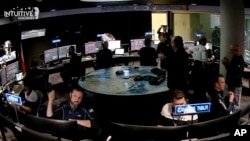A private U.S. lunar lander touched down on the moon Thursday, but contact with the craft was weak, company officials said.
There were no immediate updates on the lander's condition from the company, Intuitive Machines.
Tension mounted in the company's command center in Houston, as controllers awaited a signal from the spacecraft some 400,000 kilometers away. It arrived about 10 minutes later.
"We're evaluating how we can refine that signal," said mission director Tim Crain. "But we can confirm, without a doubt, that our equipment is on the surface of the moon."
The lander, Odysseus, descended from a moon-skimming orbit and guided itself toward the surface, searching for a relatively flat spot among all the cliffs and craters near the south pole.
The lander's choreographed descent was the first for the U.S. since 1972, when Apollo 17's Gene Cernan and Harrison Schmitt left the last boot prints in the gray dust.
Odysseus, carrying NASA experiments, reached the moon Wednesday, six days after rocketing from Kennedy Space Center in Florida.
The six-footed, carbon-fiber-and-titanium lander — 4.3 meters tall — carried six experiments for NASA. The space agency gave the company $118 million to build and fly the lander, part of its effort to commercialize lunar deliveries ahead of the planned return of astronauts in a few years.
The U.S. bowed out of the lunar landscape in 1972 after NASA's Apollo program put 12 astronauts on the surface. A Pittsburgh company, Astrobotic Technology, gave it a shot last month, but was derailed by a fuel leak that resulted in the lander plunging back through Earth's atmosphere and burning up.
Intuitive Machines is the first private business to successfully pull off a lunar landing.
Intuitive Machines' target was 300 kilometers shy of the south pole, around 80 degrees latitude and closer to the pole than any other spacecraft has come. The site is relatively flat, but surrounded by boulders, hills, cliffs and craters that could hold frozen water, a big part of the allure. The lander was programmed to pick, in real time, the safest spot near the so-called Malapert A crater.
The solar-powered lander was intended to operate for a week, until the long lunar night.
Besides NASA's tech and navigation experiments, Intuitive Machines sold space on the lander to Columbia Sportswear to fly its newest insulating jacket fabric; sculptor Jeff Koons for 125 mini moon figurines; and Embry-Riddle Aeronautical University for a set of cameras to capture pictures of the descending lander.







